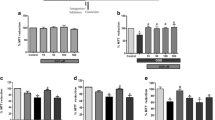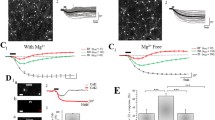Summary
Four hours following cryo-injury rat cerebral pericapillary astrocytes from the perilesional area were markedly swollen occupying 17% of the pericapillary space as compared to 11% in sham operated controls. Ornithine decarboxylase activity and polyamine levels were increased over sham controls. The astrocytic swelling, the percentage of the pericapillary space occupied by astrocytic processes, and polyamine levels were reduced to near control levels by the following: (1) α-difluoromethylornithine; (2) Ifenprodil; and (3) MK-801. α-Difluoromethylornithine is a specific inhibitor of ornithine decarboxylase, Ifenprodil is an inhibitor of the polyamine binding site on the n-methyl-d-aspartate receptor, and MK-801 is an antagonist to n-methyl-d-aspartate binding to the n-methyl-d-aspartate receptor. Addition of putrescine, the product of ornithine decarboxylase activity, reversed the effect of α-difluoromethylornithine and restored the pericapillary swelling. Putrescine did not affect the MK-801-induced reduction in pericapillary astrocytic swelling. Therefore, polyamines and the n-methyl-d-aspartate receptor modulate excitotoxic responses to cryo-injury in pericapillary cerebral astrocytes.
Similar content being viewed by others
References
Barres, B. A., Chun, L. L. Y. &Corey, S. P. (1990a) Ion channels in vertebrate glia.Annual Review of Neuroscience 13, 441–74.
Barres, B. A., Koroshetz, W. J., Swartz, K. J., Chun, L. L. Y. &Corey, D. (1990b) Ion channel expression by white matter glia: the O-2A glial progenitor cell.Neuron 4, 507–24.
Barron, K. D., Dentinger, M. P., Kimelberg, H. K., Nelson, L. R., Bourke, R. S., Kegan, S., Mankes, R. &Cragoe, E. J., Jr (1988) Ultrastructural features of a brain injury model in Cat. 1. Vascular and neurological changes and the prevention of astroglial swelling by a fluorenyl (aryloxy) alkanoic acid derivative (L-644, 711).Acta Neuropathologica 75, 295–307.
Benveniste, H., Drejer, J., Schousboe, A. &Diemer, N. H. (1984) Elevation of the extracellular concentrations of glutamate and aspartate in rat hippocampus during transient cerebral ischemia monitored by intracerebral microdialysis.Journal of Neurochemistry 43, 1369–74.
Bowman, C. L. &Kimelberg, H. K. (1984) Excitatory amino acids directly depolarize rat brain astrocytes in primary cultures.Nature 311, 656–9.
Carter, C., Rivy, J. -P. &Scatton, B. (1989) Ifenprodil and SL 82.0715 are antagonists at the polyamine site of the N-methyl-D-aspartate (NMDA) receptor.European Journal of Pharmacology 64, 611–12.
Chan, P. H. &Chu, L. (1989) Ketamine protects cultured astrocytes from glutamate-induced swelling.Brain Research 487, 380–3.
Chan, P. H., Fishman, R. A., Lee, J. L. &Candelise, L. (1979) Effects of excitatory neurotransmitter amino acids on swelling of rat brain cortical slices.Journal of Neurochemistry 22, 1309–15.
Choi, D. W. (1988) Glutamate neurotoxicity and diseases of the nervous system.Neuron 1, 623–34.
Haglid, K. G., Wang, S., Hamberger, A., Lehmann, A. &Moller, C. J. (1991) Neuronal and glial marker proteins in the evaluation of the protective action of MK-801.Journal of Neurochemistry 56, 1957–61.
Hertz, L. (1978) An intense potassium uptake into astrocytes, its further enhancement by high concentrations of potassium and its possible involvement in potassium homeostasis at the cellular level.Brain Research 145, 202–8.
Hertz, L., Goldstein, M. H. &Hamberger, A. C. (1974) Uptake of the neurotransmitter candidate glutamate by glia.Nature 299, 663–4.
Kettenman, H. &Schachner, M. (1985) Pharmacological properties of GABA, glutamate and aspartate induced depolarizations in cultured astrocytes.Journal of Neuroscience 5, 3295–301.
Kimbelberg, H. (1987) Anisotonic media and glutamateinduced ion transport and volume responses in primary astrocyte cultures.Journal de Physiologie 82, 294–303.
Kimelberg, H., Jalonen, T. &Walz, W. (1993) Regulation of the brain microenvironment: transmitters and ions. InAstrocytes: Pharmacology and Function (edited byMurphy, S.) pp. 193–228. New York: Academic Press.
Koenig, H., Goldstone, A. D. &Lu, C. Y. (1989) Blood-brain barrier breakdown in cold-injured brain is linked to a biphasic stimulation of ornithine decarboxylase activity and polyamine synthesis: both are coordinately inhibited by verapamil, dexamethasone, and aspirin.Journal of Neurochemistry 52, 101–9.
Koenig, H., Goldstone, A. D., Lu, C. Y., Trout, J. J. &Iqbal, Z. (1991) NMDA receptors on brain capillary mediate cold injury-induced activation of polyamine synthesis and blood-brain barrier breakdown.Society for Neuroscience Abstracts 17, 7.
Koenig, H., Trout, J. J., Goldstone, A. D. &Lu, C. Y. (1992a) Capillary NMDA receptors regulate blood-brain barrier function and breakdown.Brain Research 588, 297–303.
Koenig, H., Trout, J. J., Goldstone, A. D. &Lu, C. Y. (1992b) NMDA receptors mediate activation of polyamine synthesis and blood-brain barrier breakdown after cold injury. InThe Role of Neurotransmitters in Brain Injury. (edited byGlobus, M. T. &Dietrich, W. D.) pp. 279–83. New York: Plenum Press.
Lowry, O. H., Rosenbrough, N. J., Farr, A. L. &Randall, R. J. (1951) Protein measurement with the Polin phenol reagent.Journal of Biological Chemistry 193, 265–75.
Matyja, E. (1986) Morphologic evidence of a primary response of glia to kainic acid administration into the rat neostriatum: studiedin vivo andin vitro.Experimental Neurology 92, 609–23.
McCarthy, K. D., Salm, A. &Lerea, L. S. (1988) Astroglial receptors and their regulation of intermediate filament protein phosphorylation. InGlial Cell Receptors. (edited byKimelberg, H. K.) pp. 1–22. New York: Raven Press.
Nag, S. &Riopelle, R. J. (1990) Spinal neuronal pathology associated with continuous intrathecal infusion of N-methyl-D-aspartate in the rat.Acta Neuropathologica 81, 7–13.
Olney, J. W., Ho, O. L. &Rhee, C. (1971) Cytotoxic effects of acidic and sulfur containing amino acids on the infant mouse central nervous system.Experimental Brain Research 14, 61–76.
Petito, C. K., Morgello, S., Felix, J. C. &Lesser, M. L. (1990) The two patterns of reactive astrocytosis in postischemic brain.Journal of Cerebral Blood Flow and Metabolism 10, 850–859.
Reynolds, I. J. &Miller, R. J. (1989) Ifenprodil is a novel type of N-methyl-D-aspartate receptor antagonist: interaction with polyamines.Molecular Pharmacology 36, 758–65.
Rothman, S. M. &Olney, J. J. (1987) Excitotoxicity and the NMDA receptor.Trends in Neurosciences 10, 299–302.
Sontheimer, H., Kettenmann, H., Backus, K. H. &Schachner, M. (1988) Glutamate opens Na+/K+ channels in cultured astrocytes.Glia 1, 328–36.
Teichberg, V. I. (1991) Glial glutamate receptors: likely actors in brain signaling.FASEB Journal 5, 3086–91.
Travis, J. (1994) Glia: the brain's other cells.Science 266, 970–72.
Trout, J. J., Koenig, H., Goldstone, A. D. &Lu, C. Y. (1986) Blood-brain barrier breakdown by cold injury: polyamine signals mediate acute stimulation of endocytosis, vesicular transport and microvillus formation in rat cerebral capillaries.Laboratory Investigation 55, 622–31.
Trout, J. J., Koenig, H., Goldstone, A. D., Iqbal, Z., Lu, C. Y. &Siddiqui, F. (1993) N-Methyl-D-aspartate receptor excitotoxicity involves activation of polyamine synthesis: protection by α-difluoromethylornithine.Journal of Neurochemistry 60, 353–5.
Usowicz, M. M., Gallo, V. &Cull-Candy, S. G. (1989) Multiple conductance channels in type 2 cerebellar astrocytes activated by excitatory amino acids.Nature 229, 380–3.
Williams, K., Romand, C. &Molinoff, P. B. (1989) Effects of polyamines on the binding of [3H]MK-801 to the N-methyl-D-asparate receptor: pharmacological evidence for the existence of a polyamine binding site.Molecular Pharmacology 36, 575–81.
Author information
Authors and Affiliations
Rights and permissions
About this article
Cite this article
Trout, J.J., Lu, C.Y., Goldstone, A.D. et al. Polyamines and NMDA receptors modulate pericapillary astrocyte swelling following cerebral cryo-injury in the rat. J Neurocytol 24, 341–346 (1995). https://doi.org/10.1007/BF01189061
Received:
Revised:
Accepted:
Issue Date:
DOI: https://doi.org/10.1007/BF01189061




